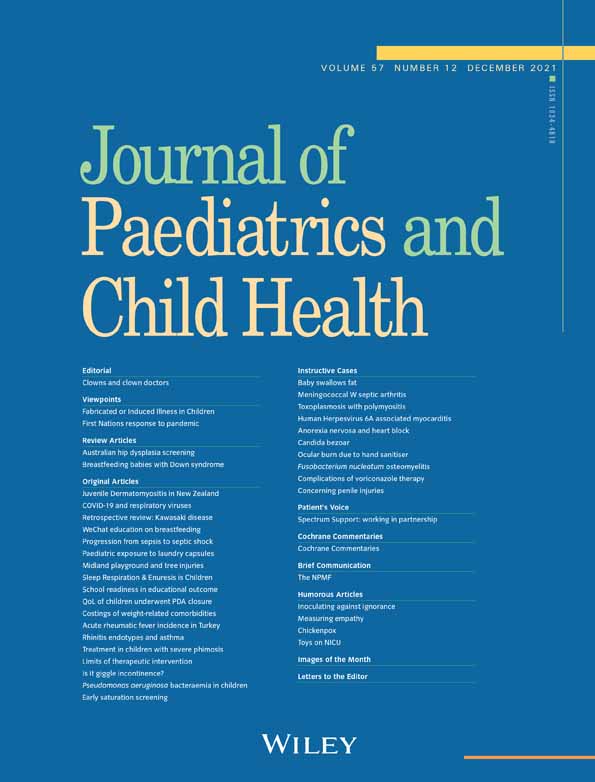School Support for Children with Type 1 Diabetes Mellitus: The Parental Perspective
Conflict of interest: None declared.
SCHOOL SUPPORT FOR CHILDREN WITH TYPE 1 DIABETES MELLITUS: THE PARENTAL PERSPECTIVE
Integration of diabetes care into the school day aims to optimise glycaemic control in addition to limiting any negative psychosocial impact of Type 1 Diabetes (T1D) on students.1, 2 To facilitate this, specific school-based guidelines recommend the use of a diabetes management plan (DMP) and support participation of all students in school activities.1 To enhance Australian data, we explored parental perception of the T1D support available to students in Victorian schools, how the experience of these supports differed between primary and secondary school settings and the impact of T1D on participation in school activities and child wellbeing.
A structure-response questionnaire was derived from a study by Lehmkuhl and Nabors.3 Participants were parents of children with T1D who attended the diabetes outpatient clinic at the Royal Children's Hospital, Melbourne, March–June 2019. Of the 308 parents who self-approached for inclusion in this study, 279 surveys were included in the final analysis (Table 1). Overall satisfaction with diabetes school-based care was reported in 219/275 (79.6%). Staff training was identified as an issue with 82/279 (29.8%) respondents responding negatively to the level of training. Parents of secondary-level students reported use of the DMP (69.5% vs. 35.4%, p = 0.001) and were less satisfied with the communication between parents and staff (74.2% vs. 48.3%, p = 0.03), whereas 38/128 (29.7%) consider that more support should be provided to primary students (P = 0.04). Out of 274 parent respondents, 36 (13.1%) felt their child was prevented from participation in activities and 70/273 (25.6%) reported that their child felt different as a result of T1D.
| Total (n = 279) | Primary school (n = 129) | Secondary school (n = 150) | p value | |
|---|---|---|---|---|
| Males, n (%) | 143 (51.3) | 69 (53.5) | 74 (49.3) | 0.5 |
| Age, years (SD) | 12.0 (3.4) | 9.0 (2.0) | 14.7 (1.7) | <0.001 |
| Duration of diabetes diagnosis, years (SD) | 5.3 (3.8) | 3.9 (2.7) | 6.5 (4.1) | <0.001 |
| Mean duration at current school, years (SD) | 4.9 (2.5) | 5.0 (2.3) | 4.7 (2.7) | 0.3 |
| HbA1c in %, mean (SD) | 7.76 (0.96) | 7.73 (0.86) | 7.79 (1.04) | 0.6 |
| Number of performed BGL, mean (SD) | 4.7 (2.0) | 5.3 (2.0) | 4.2 (1.7) | <0.001 |
| School type, n (%) | ||||
| Public | 166 (59.5) | 85 (65.9) | 81 (54.0) | 0.04 |
| Private | 92 (33.0) | 34 (26.4) | 58 (38.7) | 0.03 |
| Other | 21 (7.5) | 10 (7.8) | 11 (7.3) | 0.90 |
| School supports received, n (%) | ||||
| Insulin administration | 25 (8.9) | 19 (14.7) | 6 (4.0) | 0.002 |
| Blood glucose levels | 89 (31.9) | 73 (56.6) | 16 (5.7) | <0.001 |
| Hypoglycaemia management | 187 (67.0) | 105 (81.4) | 82 (54.7) | <0.001 |
| Insulin regimen, n (%) | ||||
| BD | 80 (28.7) | 62 (48.1) | 18 (12.0) | <0.001 |
| Intensive | 199 (71.3) | 67 (51.9) | 132 (88.0) | |
| CGM, n (%) | ||||
| Yes | 105 (37.6) | 63 (48.8) | 42 (28.0) | <0.001 |
| No | 174 (62.4) | 66 (51.2) | 108 (72.0) | |
- BD, twice-daily injections; intensive insulin regimen – a composite of those on multiple daily injections (MDI) and continuous subcutaneous insulin infusion (CSII); CGM, continuous glucose monitoring; between-group comparisons (primary vs. secondary school) were assessed using chi-squared analyses and Student's t-test for categorical and continuous variables respectively.
This study shows that overall, parental perception of school-based diabetes care is largely positive in Victorian schools although some deficits have been identified. Our findings are similar to that of the national Diabetes in Schools assessment where the need for improved communication, staff training and DMP use were also highlighted.4 Exclusion of children with T1D from school activities is an ongoing concern,2 as full participation in activities is central to the school experience. Interestingly, while parents acknowledge that the level of support provided to secondary-level students is appropriate, the expectation of ongoing dialogue with the school remains. Improved education provided to school staff, underlies the federally funded Diabetes in Schools pilot education programme, which may need to be tailored to ensure it addresses both the medical and psychosocial needs of children with T1D.
This study was approved by the Royal Children's Hospital (RCH) Human Research Ethics Committee (Ethics ID 38367).
Acknowledgements
The authors thank Ms Julia McCombe from Murdoch Children's Research Institute for her assistance with ethics approval and Dr Julia Barrington from the Royal Children's Hospital for assistance with the final editing.




